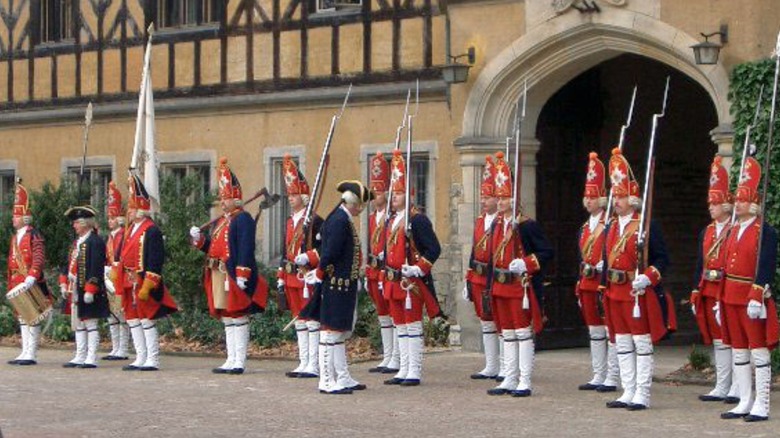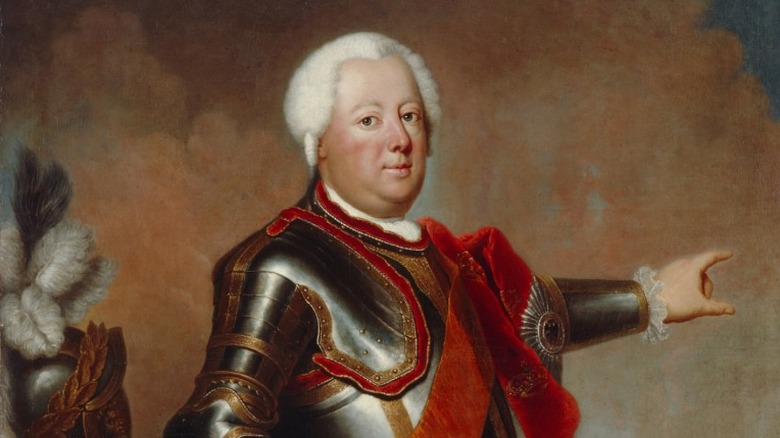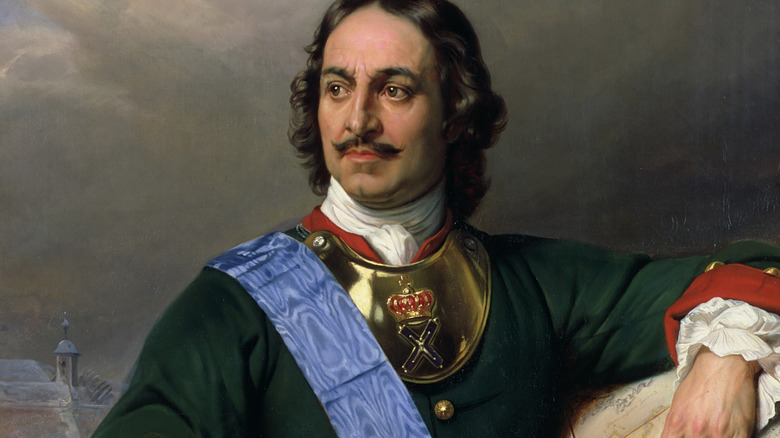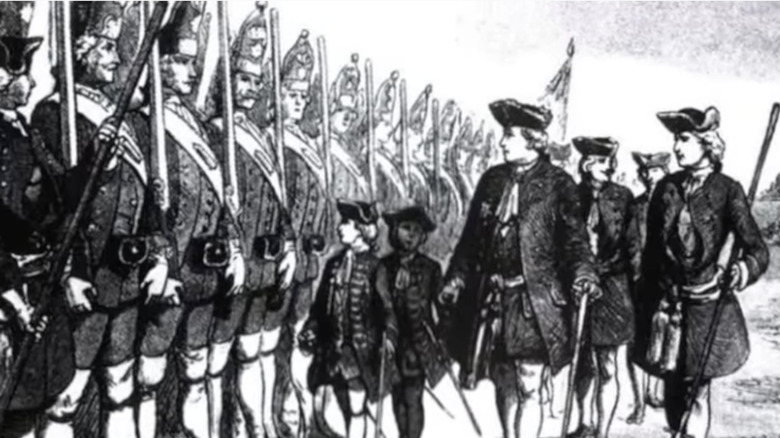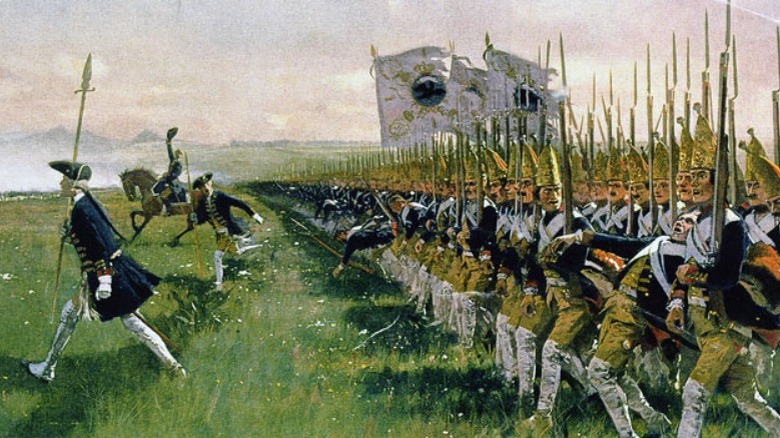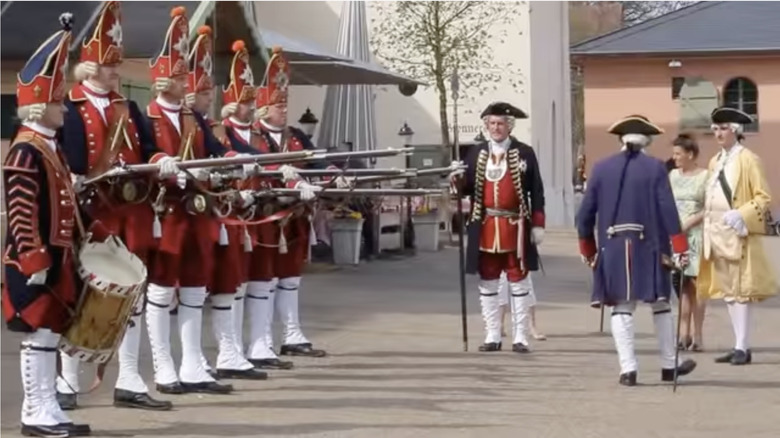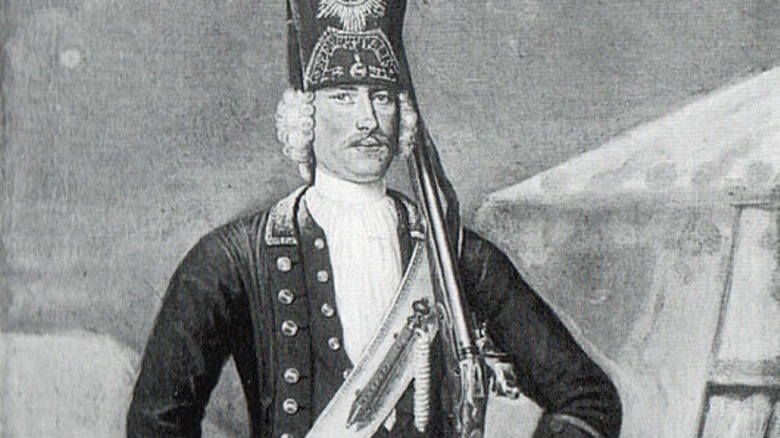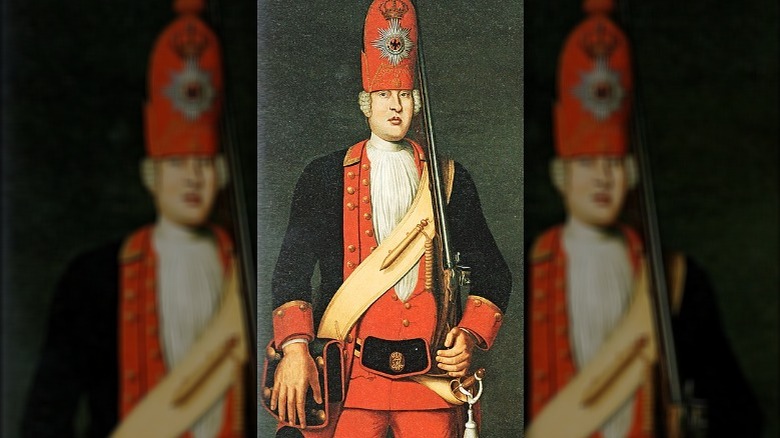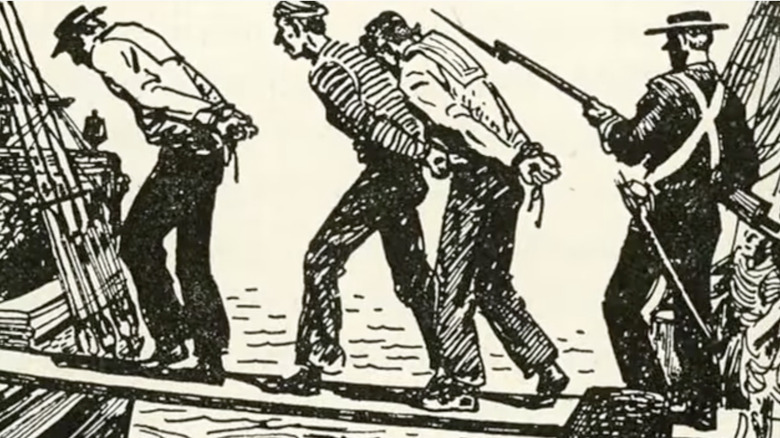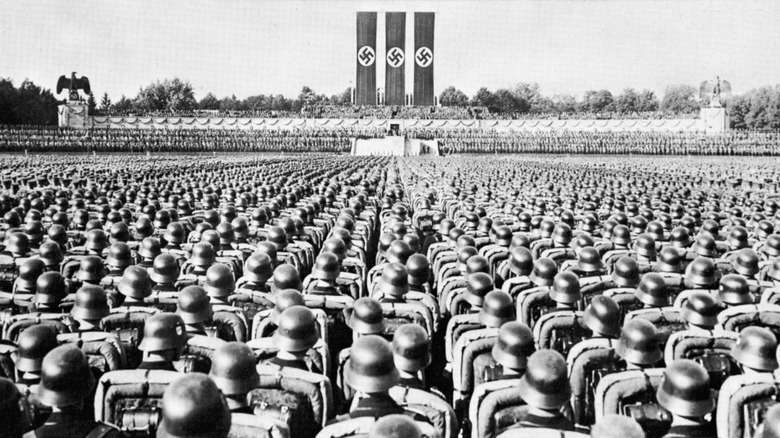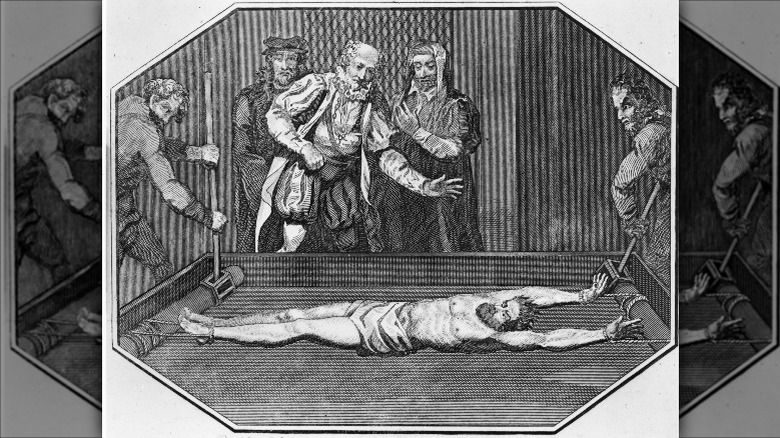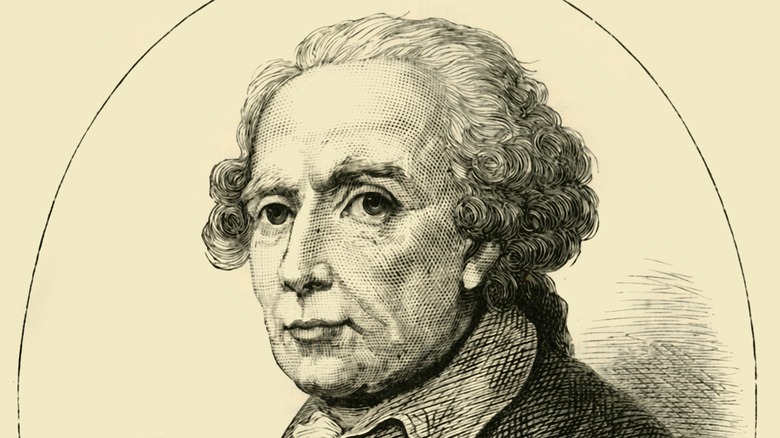The Disturbing Truth About The Time Prussia Tried To Create An Army Of Giants
In the 19th century, the Prussian Kingdom dominated Europe, and its educational system represented the best available on the continent, according to Britannica. Although Prussian control was threatened during the Revolution of 1848, which spilled over from France into the German states, strategic governance permitted the king to weather this storm, establishing a constitutional monarchy in early 1850.
But it would take the Franco-Prussian War of 1870 through 1871 to cement Prussia's role as the dominant state within the larger German Reich. This rise in dominance of Prussia was heralded by the state's absorption of all other German state-run militaries except for Bavaria, which preferred autonomy. Nevertheless, the march toward empire couldn't be denied, especially with Otto von Bismarck navigating the combined offices of Prussian minister-president and imperial chancellor. But centuries before the creation of a German empire that would pave the way for two World Wars, there was Frederick William I (via Britannica).
As king of Prussia, he alternated between salivating over tall soldiers, torturing said soldiers (sometimes to death), and traumatizing his son, the future Frederick the Great, beyond all human reason. Any one of these endeavors represented a full-time job for a lesser man, but Frederick William I juggled them with an unmatched and sadistic glee. Here's the disturbing truth behind his predilection, which led to one of Germany's first attempts at eugenics: the creation of an army of giants.
King Frederick William I loved giants
If an army of giants sounds bizarre, even stranger was King Frederick William I's obsession with super-tall soldiers, as reported by Russia Beyond. The creator of the giant army, King Frederick William I stated, "The most beautiful girl or woman in the world would be a matter of indifference to me, but tall soldiers — they are my weakness." Of course, giant soldiers were just one way that Frederick William reshaped the Prussian army.
During his reign from 1713 to 1740, King Frederick William I expanded the Prussian Army in other ways, too. He added nearly 50,000 more troops to it, growing its ranks from 38,000 to 83,000 men. The king's unwavering focus on all things military earned him the apt nickname the "Soldier King" (via History Collection).
But while growing his army represented a fairly mundane activity, building a giant regiment felt downright sexy to Frederick William. It had precedents in the armies of ancient lore, like that of the Philistines who faced off against the future King David with their so-called unbeatable hero, Goliath. But unlike that hulking human who fell to a shepherd boy with a handful of river pebbles and a leather sling, the giant army of Prussia never saw battle. Despite the lack of practicality when it came to this lanky league of warriors, the king spared no expense acquiring them, equipping them, and training them.
Size mattered for the giant army
Soldiers of the giant regiment had to measure more than six feet tall, per Russia Beyond. While not especially impressive today, they towered over the average 18th-century 5'5" male, including Frederick William I (via Ohio State News). As news spread of the king's soft spot for tall men, other monarchs used this knowledge to their advantage.
To sweeten the alliance between Prussia and Russia during the Great Northern War, Peter the Great of Russia ordered court officials to track down and apprehend 200 super-tall men to send to Prussia. He included a paper ribbon measuring 6'3" tall, representing the minimum height of the men sought for this special diplomatic mission. We don't know why Peter added the extra inches to the regiment's official height requirements, but perhaps he was trying to get brownie points, according to War History Online.
The pursuit of basketball-sized soldiers turned into a wild goose chase. After scraping the bottom of the barrel a few times, they came up with 60 men, and only about 55 of them ever ended up in Prussia. This isn't surprising when you look at history from a physical anthropology viewpoint. A study of skeletons has uncovered that men living during the Dark Ages were just about as tall as males today. But starting in the 12th century, height declined. It reached its lowest point during the 17th and 18th centuries, right when Peter the Great scoured his nation for beanpole swashbucklers.
They were known by many names
The towering army that Frederick William assembled went by various names, according to Russia Beyond. Some called them the "Potsdam Giants," referring to the marshy tract of land that the king constructed to house ten thousand people, primarily soldiers. What's more, the official name of the unit was "The Grand Grenadiers of Potsdam," reports the History Collection.
The Prussian king developed Potsdam based on inspiration from Peter the Great, who created St. Petersburg in his honor, according to Potsdam's official site. The reason Frederick William chose Potsdam over Berlin was because of the latter city's rebellious residents. At one point, rumor had it Berliners had even refused to house the "soldier king's" troops, and so Potsdam became the obvious Plan B. What's more, as one text dated to 1700 explained, "Potsdam belonged to Sire Excellency Elector of Brandenburg above ground, and below ground on waters and soil, as far the district extends."
But not every title for the giant army referred specifically to the city of Potsdam. Many people referred to them simply as the "Lange Kerls," which translated from German as the "Tall Fellows" (via War History Online). Considering the unit had little else going for them but height, the name suited them well.
They looked great but didn't see action
Prussia's giant army looked impressive with their lanky builds and strategically designed uniforms, according to War History Online. They were outfitted in stunning blue and red uniforms and Grenadier caps, adding roughly 18 inches to their height (via Russia Beyond). Coupled with sturdy boots with prominent heels, they towered above other soldiers but did little else, acting more like Frederick's personal circus show than a military unit.
Nonetheless, their training and discipline made them legendary. Constant practice ensured they moved in perfect synchronicity. Or, as one witness put it, "At the word of command, only one click was heard in the line, one measured step in marching, and one report in platoon firing," per Walter Nelson's "The Soldier Kings: The House of Hohenzollern," Training methods meted out on the giants to guarantee this level of excellence included merciless beatings, other cruel punishments, and the inducement of terror. While Frederick William I bragged that no one could resist his giant regiment, the unit remained perpetually untested.
Although the Tall Fellows never worried about being combat-ready, the drilling never stopped. This training prepared them for appearances at the king's court and military parades. They also provided private entertainment for the king as his living toy soldiers. For instance, when the king was under the weather, he demanded the regiment march through his room to boost his spirits.
Soldiers enjoyed many height-based benefits
Not only did impressive stature earn a man entrée into the Potsdam Giants, but it also ensured great pay, according to Russia Beyond. The taller the soldier, the more he earned. They also enjoyed the best accommodations and food available despite the fact they never had to fight in battle. They received this preferential treatment because of their role as the direct servants of the king, per War History Online. That said, Frederick William settled for nothing less than perfection in their appearance and drilling precision.
At one point, the Potsdam Giants included men measuring upwards of nine feet tall (via Walter Nelson's "The Soldier Kings: The House of Hohenzollern")! The tallest of these men also inevitably became favorites of the king. As a result, they had other special treatment showered upon them. This included being memorialized through life-sized portraits. And one of the king's absolute favorite men, a former Norwegian blacksmith, was sculpted in marble after his death.
One of the giant regiment's preferred past times was drinking. In a letter describing one dancing event, Baron Bielfeld explained how the men got wasted on bumpers of champagne while dancing with each other. Apparently, ladies were either not permitted or not invited to the all-male gathering. Bielfeld noted, "All these corpulent machines are great wine-bibbers," in reference to the Potsdam Giants.
The benefits weren't worth it
Despite the luxuries that accompanied participation as one of the Potsdam Giants, it wasn't all fun and games. According to Walter Nelson's "The Soldier Kings: The House of Hohenzollern," morale remained the Achilles' Heel of the regiment. Every year, approximately 250 men successfully deserted. Other desperate troops went to great lengths to extricate themselves from the unit, even resorting to taking their own lives, mutilation, and committing crimes.
Those caught fleeing the army faced steep punishments, including having their ears and noses sliced off and running a gauntlet (via The Past Web). Deserters were hunted down across the European continent, and bounties were placed on their heads to motivate the citizenry to turn them in. Despite such harsh reprisals and attempts to turn the populace against fleeing soldiers, specific safe havens emerged. For example, Amsterdam, the capital of the Netherlands, was rumored to be chock full of men wearing Prussian military uniforms.
Russian recruits of the "Tall Fellows" wrote to Peter the Great pleading for their freedom, as reported by Russia Beyond. He instructed William Frederick to return his recruits so they could be reunited with their families and friends. Unfortunately, the Russians didn't keep good records when it came to the Potsdam Giants. But we do know that of the 152 well-statured men sent to serve with the unit, 95 were repatriated back to Russia in 1724. British members of the Potsdam Giants also petitioned their nation for help, but Frederick William refused to let them leave.
The Potsdam Giants were an international bunch
King Frederick William I got a jump start on his regiment by rounding up every tall-statured man in Prussia and then the German states, as reported by Walter Nelson's "The Soldier Kings: The House of Hohenzollern." The regiment initially contained 1,200 men. But Frederick William had a much grander vision for his decorative unit, and it involved swelling the ranks three to four times.
As a result, the unit eventually expanded to 4,000 members, representing an international collection of tall men from all over Europe as well as Asia, Africa, and the Americas. They included the loftiest soldiers from France, Italy, Spain, Portugal, Hungary, Croatia, Poland, England, Ireland, Russia, Turkey, Sweden, Denmark, and Ethiopia, among other countries.
This international hodgepodge of individuals found their way into the unit through various means, as reported by War History Online. While some volunteered, others were compelled into service or even kidnapped. No method proved too low, criminal, or outlandish to recruit for the king's regiment. As the hunt for giants became well-publicized, the price for ascertaining them increased. Despite the king's frugal reputation, he spared no expense when it came to amassing his super-tall soldiers.
Begging, borrowing, and stealing giants
To fill out the ranks of his giant army, King Frederick William I turned to other nations for recruits (via War History Online). He paid Prussian parents to hand over tall boys and resorted to kidnapping to secure men like the Irishman James Kirkland. Kirkland stood more than seven feet tall and served in the regiment after getting spotted working as Baron Borck's footman, per Russia Beyond.
Officers tasked with giant-hunting faced stark punishment when they failed to make quotas, according to The Past Web. One major received a sentence of six years for coming before the king empty-handed. And other historical sources tell us that two officers were made examples of by being "broken like a glass" in front of the troops they led. The pressures didn't end there. Even lucky Prussian officers who escaped punitive action for a lack of giants reaped negative consequences, their pay and food never sure.
Nobody proved immune to the king's giant hunting scheme. Frederick William's officers ranged far and wide, even kidnapping an Italian priest from Tyrol and a monk from a monastery in Rome, as reported in Walter Nelson's "The Soldier Kings: The House of Hohenzollern." When Frederick William's varied efforts at securing tall men weren't sufficient, he turned to another means of filling his regiment's ranks: eugenics. While this attempt at playing god had mixed results, it set a dangerous precedent that the Nazis would revisit in the 20th century.
Dabbling in eugenics to populate the Potsdam Giants
When gathering enough giants from the four corners of the globe failed, King Frederick William I didn't give up on his giant army (via the History Collection). Instead, he turned to eugenics to engineer a so-called "super race" of giants. Part of this program involved breeding extra tall women with the members of the Potsdam Giants, one of the first eugenics experiments and an inspiration for the Nazi's Third Reich centuries later.
His experiments in breeding human beings to achieve specific physical traits even drew the attention of Charles Darwin in the 19th century. Darwin cited the Potsdam Giants as an example of selective breeding among people rather than animals. While the king enjoyed limited success in this multi-generational experiment, he paved a road in a very dangerous direction.
In the 20th century, Hitler would revisit this road, dangerously combining an admixture of toxic social Darwinism with the militarism branded by Prussia. His vision of eugenics borrowed various elements from the early experiments of Frederick William as a new regime sought to create cutting-edge super soldiers and ideal citizens, per War History Online.
The king tortured members of the regiment
If you think eugenics experiments represented the worst part of being a Potsdam Giant, think again (via War History Online). Besides forcing soldiers of the Potsdam Giants to take extra tall brides, King Frederick William decided to stretch the possibilities even further. He turned to torture to do this, placing the men on specially designed racks where he ordered them pulled apart like silly putty.
The king oversaw these torture sessions, reportedly eating lunch during the activities. The idea behind the rack was to permanently stretch the soldiers. Rumor has it that Frederick William I observed these sessions while taking his daily lunch break, as reported by The Vintage News.
At the time, the rack was a well-known torture device used throughout Europe and the British Isles to ascertain confessions, according to Historic UK. An excruciating experience, it led to the slow dislocation of a victim's limbs, eventually ripping joints apart. In other words, it wasn't meant as a primitive medical treatment or growth encouragement. Instead of having the desired effect, stretching his troops on the rack often resulted in their deaths. Eventually, the practice stopped to the relief of the Grand Grenadiers. Apparently, so many soldiers died that the king could no longer stomach the risk.
Disbanding the giant army
Between 1713 and 1735, King Frederick William I spent more than 12,000,000 thalers on the acquisition of his massive army, according to Walter Nelson's "The Soldier Kings: The House of Hohenzollern." But the effort died with him. Frederick the Great, his son, had no interest in tall soldiers.
According to War History Online, Frederick the Great disbanded the regiment, arguing it drained the Prussian state economically. He dispersed the men to regular units bringing the frightful Potsdam Giants experiment to an abrupt and welcome halt. Officially ended in 1806, tall men in Europe and abroad breathed a sigh of relief.
Frederick the Great's refusal to honor his father's memory by keeping the beloved giant regiment intact came as no surprise to anyone well acquainted with the Hohenzollerns. After all, Frederick William I ruthlessly abused his son, Fritz, in his youth (via History Collection). At one point, he had Frederick's tutor and a member of the King's Guard, Hans Hermann von Katte, beheaded in front of Fritz. His only crime was trying to help the young royal escape the abusive clutches of his father, who made public beatings a regular part of the Hohenzollern parenting toolkit. In this context, disbanding what his father so loved must've felt a little cathartic to Frederick the Great.
